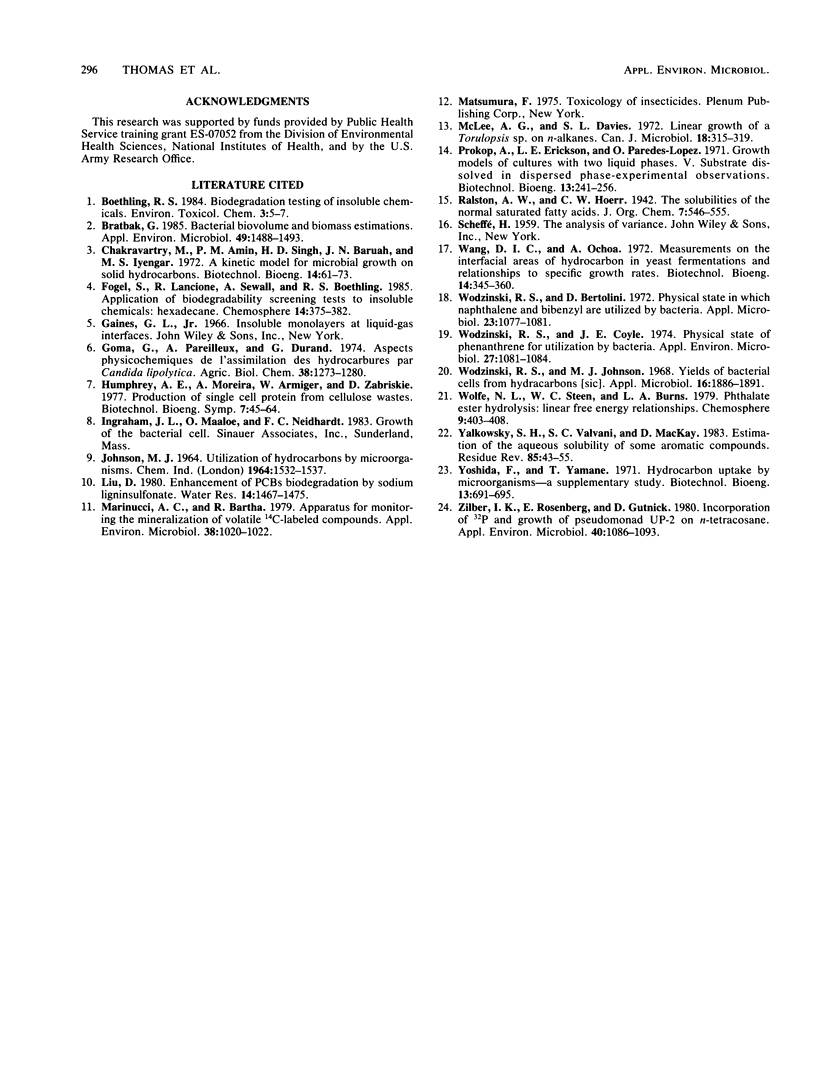Abstract
We conducted a study of the relationship between the dissolution rates of organic compounds that are sparingly soluble in water and the biodegradation of these compounds by mixed cultures of bacteria. The rates of dissolution of naphthalene and 4-chlorobiphenyl were directly related to their surface areas. The bacteria caused a decline in the concentration of the soluble substrate. The rate of bacterial growth fell abruptly when 4-chlorobiphenyl or naphthalene was no longer detectable in solution. The population continued to increase in media with different surface areas of insoluble 4-chlorobiphenyl, but the final counts were higher in media in which the surface areas of the substrate were larger. The rates of dissolution of palmitic acid, octadecane, di(2-ethylhexyl) phthalate, and 1-naphthyl N-methylcarbamate were determined in the absence of microorganisms. A mixed culture of microorganisms mineralized palmitic acid, di(2-ethylhexyl) phthalate, and Sevin (1-naphthyl N-methylcarbamate) at a logarithmic rate, but octadecane mineralization was linear. The rates of mineralization at the end of the active phase of the biodegradation were lower than the rate of dissolution of palmitic acid but higher than the rate of dissolution of octadecane in the uninoculated medium. We suggest that spontaneous dissolution rates are only one of the factors that govern the rates of biodegradation.
Full text
PDF






Selected References
These references are in PubMed. This may not be the complete list of references from this article.
- Bratbak G. Bacterial biovolume and biomass estimations. Appl Environ Microbiol. 1985 Jun;49(6):1488–1493. doi: 10.1128/aem.49.6.1488-1493.1985. [DOI] [PMC free article] [PubMed] [Google Scholar]
- Marinucci A. C., Bartha R. Apparatus for monitoring the mineralization of volatile C-labeled compounds. Appl Environ Microbiol. 1979 Nov;38(5):1020–1022. doi: 10.1128/aem.38.5.1020-1022.1979. [DOI] [PMC free article] [PubMed] [Google Scholar]
- McLee A. G., Davies S. Linear growth of a Torulopsis sp. on n-alkanes. Can J Microbiol. 1972 Mar;18(3):315–319. doi: 10.1139/m72-048. [DOI] [PubMed] [Google Scholar]
- Prokop A., Erickson L. E., Paredes-Lopez O. Growth models of cultures with two liquid phases. V. Substrate dissolved in dispersed phase--experimental observations. Biotechnol Bioeng. 1971 Mar;13(2):241–256. doi: 10.1002/bit.260130207. [DOI] [PubMed] [Google Scholar]
- Wang D. I., Ochoa A. Measurements on the interfacial areas of hydrocarbon in yeast fermentations and relationships to specific growth rates. Biotechnol Bioeng. 1972 May;14(3):345–360. doi: 10.1002/bit.260140307. [DOI] [PubMed] [Google Scholar]
- Wodzinski R. S., Bertolini D. Physical state in which naphthalene and bibenzyl are utilized by bacteria. Appl Microbiol. 1972 Jun;23(6):1077–1081. doi: 10.1128/am.23.6.1077-1081.1972. [DOI] [PMC free article] [PubMed] [Google Scholar]
- Wodzinski R. S., Coyle J. E. Physical state of phenanthrene for utilization by bacteria. Appl Microbiol. 1974 Jun;27(6):1081–1084. doi: 10.1128/am.27.6.1081-1084.1974. [DOI] [PMC free article] [PubMed] [Google Scholar]
- Wodzinski R. S., Johnson M. J. Yields of bacterial cells from hydrocarbons. Appl Microbiol. 1968 Dec;16(12):1886–1891. doi: 10.1128/am.16.12.1886-1891.1968. [DOI] [PMC free article] [PubMed] [Google Scholar]
- Yoshida F., Yamane T. Hydrocarbon uptake by microorganisms--a supplementary study. Biotechnol Bioeng. 1971 Sep;13(5):691–695. doi: 10.1002/bit.260130509. [DOI] [PubMed] [Google Scholar]
- Zilber I. K., Rosenberg E., Gutnick D. Incorporation of P and Growth of Pseudomonad UP-2 on n-Tetracosane. Appl Environ Microbiol. 1980 Dec;40(6):1086–1093. doi: 10.1128/aem.40.6.1086-1093.1980. [DOI] [PMC free article] [PubMed] [Google Scholar]


